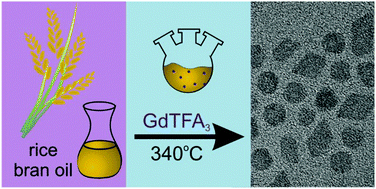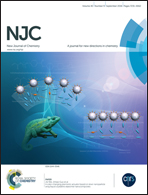Rice oil as a green source of capping ligands for GdF3 nanocrystals†
Abstract
A new synthesis route for colloidal GdF3 nanocrystals was proposed via a thermolysis of trifluoroacetate salts. Its novelty arises from the application of a commercially available rice oil (being a mixture of natural triglycerides) as the synthesis solvent. Rice oil decomposes at ∼254 °C into glycerol and three fatty acids, being a green source of capping ligands. Rapid nucleation with a low concentration of ligands results in monodisperse nanocrystals, while delayed ligand activation results in well-stabilized nanocrystals in the final stage of the synthesis. The nanocrystals show a synthesis time and temperature dependent size (3–11 nm) and shape (spherical and rhombic). We determined a size range (5.6–9.4 nm) in which the nanocrystals show double morphology (spherical and rhombic), while smaller and bigger NCs exist only in a spherical or a rhombic form, respectively. Detailed analysis of the nanocrystal morphology was followed by spectroscopic investigations of their optical properties. We determined a significant influence of a residual oxygen atom and a high surface to volume ratio on the excitation and emission of Eu3+ ions. The contribution of the oxygen diminishes at high temperature and/or with prolonged synthesis.


 Please wait while we load your content...
Please wait while we load your content...